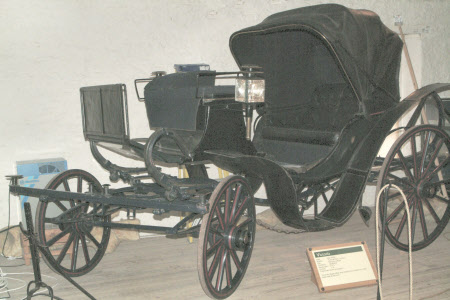Victoria
Turrill and Sons
Category
Carriages & other vehicles
Date
1850 - 1890
Materials
Painted wood body with a leather hood, wool cloth upholstery and four iron shod wheels.
Measurements
219.5 x 348 x 170cm (7ft 2 1/4in x 11ft 5in x 5ft 7in)
Place of origin
London
Order this imageCollection
National Trust Carriage Museum
NT 272872.1.1
Caption
Victorias were introduced by the future King Edward VII from Paris and were made popular by the patronage of Queen Victoria who favoured this carriage style. The low access, elegant style and comfortable seating made it very popular with ladies for fine weather use. This Victoria is hung on leather braces from C-springs, it was difficult to fit a brake, therefore a drag shoe was used. It was placed under the nearside back wheel and prevented that wheel from turning when going down hill.
Summary
Apron. Victoria built for the Marquess of Bute by Turrill and Sons, London between 1850 to 1890. Victoria (four wheels) for a pair of horses. This carriage has a shallow nautilus shell body with hinged occasional seat in the back panel of the boot. The coachman’s seat has single seat rails and there is a single seat in the forward boot. A storm apron is fitted to the carriage to keep the passengers dry. The body is sprung on C and under springs and has a drag shoe. Upholsterd in blue leather and textile, with two cushions. There are two candle lamps. The livery is in dark green and black with red lining and Coat of arms on both side panels and rear.
Full description
Victorias were popular in the late 19th century, particularly with ladies, the low body providing easy access for them in the full dresses then worn. Although essentially open carriages, they have a folding leather head over the principal seat. This example is a panel boot Victoria (the boot being the structure beneath the coachman’s seat) and it has a small extra hinged seat which stows in the back panel of the boot. There are spikes on the hind axle bed to discourage small boys from jumping on for a free lift. Victorias were coachman-driven, with a groom beside him, and could be pulled by a single horse or a pair. It is difficult to fit a brake satisfactorily to a carriage with a body hung on leather braces from C springs, so a drag shoe is fitted, which is placed under the nearside hind wheel to brake it when going down hill, and hung under the carriage when not in use.
Marks and inscriptions
On the brass axle caps.: TURRILL & SONS * LONDON On the silver candle lamp tops.: TURRILL & SONS LONDON On the axle. Found when nearside hind wheel was removed.: TURRILL & SONS LONDON On front offside internal wheel components : D35 On front nearside internal wheel components.: D35 On rear offside internal wheel components.: D35 On rear offside internal wheel components.: D35 On side panel.: Coat of arms.
Makers and roles
Turrill and Sons, coach builder
